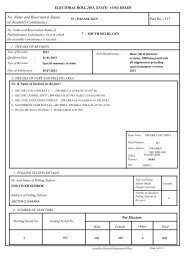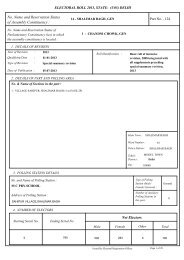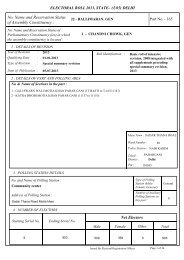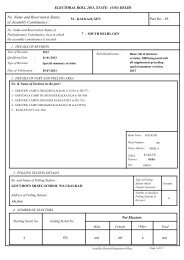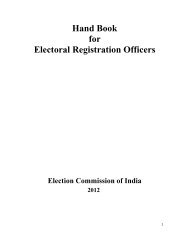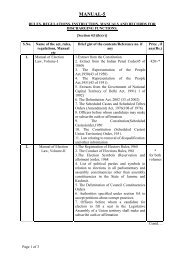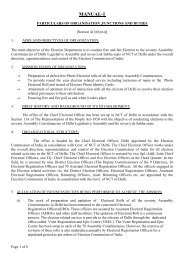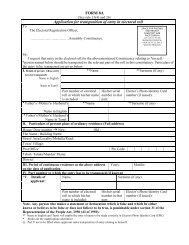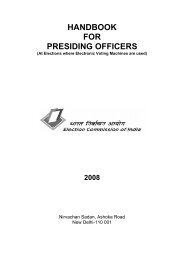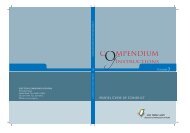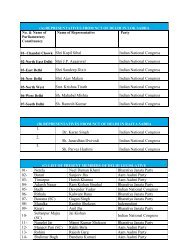Manual of Election Law_Volume II - Home: Chief Electoral Officer ...
Manual of Election Law_Volume II - Home: Chief Electoral Officer ...
Manual of Election Law_Volume II - Home: Chief Electoral Officer ...
Create successful ePaper yourself
Turn your PDF publications into a flip-book with our unique Google optimized e-Paper software.
196<br />
1 [(i) "State" includes the National Capital Territory <strong>of</strong> Delhi and the Union territory <strong>of</strong> Pondicherry;]<br />
(j) "Sub-paragraph" means a sub-paragraph <strong>of</strong> the paragraph in which the word occurs; 2 ***<br />
3 [(jj) “Union territory” means Union territory other than the National Capital Territory <strong>of</strong> Delhi and the Union<br />
territory <strong>of</strong> Pondicherry; and]<br />
(k) words and expressions used but not defined in this Order but defined in the Representation <strong>of</strong> the People<br />
Act, 1950 (43 <strong>of</strong> 1950), or the rules made thereunder or in the Representation <strong>of</strong> the People Act, 1951 (43 <strong>of</strong> 1951),<br />
or the rules made thereunder shall have the meanings respectively assigned to them in those Acts and rules.<br />
(2) The General Clauses Act, 1897 (10 <strong>of</strong> 1897) shall, as far as may be, apply in relation to the interpretation <strong>of</strong> this<br />
Order as it applies in relation to the interpretation <strong>of</strong> a Central Act.<br />
4 * * * * *<br />
4. Allotment <strong>of</strong> symbols.—In every contested election a symbol shall be allotted to a contesting candidate in<br />
accordance with the provisions <strong>of</strong> this Order and different symbols shall be allotted to different contesting candidates at<br />
an election in the same constituency.<br />
5. Classification <strong>of</strong> symbols.—(1) For the purpose <strong>of</strong> this Order symbols are either reserved or free.<br />
(2) Save as otherwise provided in this Order, a reserved symbol is a symbol which is reserved for a recognised<br />
political party for exclusive allotment to contesting candidates set up by that party.<br />
(3) A free symbol is a symbol other than a reserved symbol.<br />
5 [6. Classification <strong>of</strong> political parties.—(1) For the purposes <strong>of</strong> this Order and for such other purposes as the<br />
Commission may specify as and when necessity therefor arises, political parties are either recognised political parties<br />
or unrecognised political parties.<br />
(2) A recognised political party shall either be a National party or a State party.<br />
6A. Conditions for recognition as a National party.—A political party shall be treated as a recognized National party,<br />
if, and only if,—<br />
either (A) (i) the candidates set up by it, in any four or more States, as the last general election to the House <strong>of</strong> the People, or<br />
to the Legislative Assembly <strong>of</strong> the State concerned, have secured not less than six per cent. <strong>of</strong> the total valid votes polled in<br />
their respective States at that general election; and (ii) in addition, it has returned at least four members to the House <strong>of</strong> the<br />
People at the aforesaid last general election from any State or States;<br />
or (B) (i) its candidates have been elected to the House <strong>of</strong> the People, at the last general election to that House, from at least<br />
two per cent. <strong>of</strong> the total number <strong>of</strong> parliamentary constituencies in India, any fraction exceeding one-half being counted as<br />
one; and (ii) the said candidates have been elected to that House from not less than three States.<br />
6B. Conditions for recognition as a State party.—A political party, other than a National party, shall be treated as a<br />
recognised State party in a State or States, if, and only if,—<br />
either (A)(i) the candidates set up by it, at the last general election to the House <strong>of</strong> the People, or to the Legislative Assembly<br />
<strong>of</strong> the State concerned, have secured not less than six per cent. <strong>of</strong> the total valid votes polled in that State at that general<br />
election; and (ii) in addition, it has returned at least two members to the Legislative Assembly <strong>of</strong> the State at the last general<br />
election to that Assembly;<br />
or (B) it wins at least three per cent. <strong>of</strong> the total number <strong>of</strong> seats in the Legislative Assembly <strong>of</strong> the State (any fraction<br />
exceeding one-half being counted as one), or at least three seats in the Assembly, whichever is more, at the aforesaid general<br />
election.<br />
6C. Conditions for continued recognition as a National or State party.—If a political party is recognized as a National<br />
party under paragraph 6A, or as a State party under paragraph 6B, the question whether it shall continue to be so recognized<br />
after any subsequent general election to the House <strong>of</strong> the People or, as the case may be, to the Legislative Assembly <strong>of</strong> the<br />
State concerned, shall be dependent upon the fulfilment by it <strong>of</strong> the conditions specified in the said paragraphs on the results<br />
<strong>of</strong> that general election.]<br />
___________________________________________________________________________<br />
1. Subs. by Notifn. No. O.N. 6(E), dated the 8th June, 1999.<br />
2. Omitted, ibid.<br />
3. Ins., ibid.<br />
4. Paragraph (3) omitted by Notifn. No. O.N. 21(E), dated the 23 rd March, 1992 (w.e.f. 25-3-1992).<br />
5. Subs. by Notifn. No. O.N. No. 63(E), dated 1st December, 2000, for s. 6.



